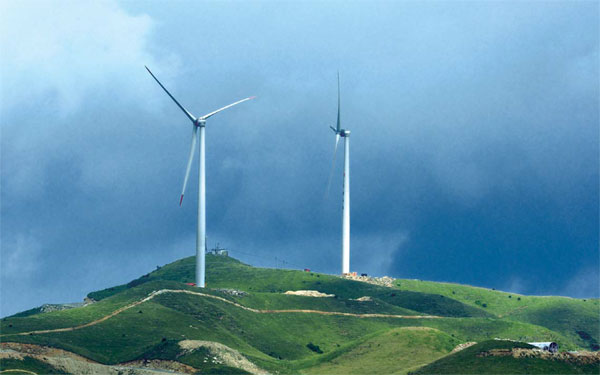Britain is an environment exemplar for China
By Cecily Liu (China Daily Europe) Updated: 2015-10-02 09:44Investment bank 'suits agenda of market liberalization and push for green cities'
China's establishment of a green investment bank will fundamentally transform the way economic growth and environmental conservation work together, says Nick Mabey, chief executive and a founder of Third Generation Environmentalism, known as E3G.
Mabey, whose team had a role in setting up the United Kingdom's Green Investment Bank, is working with representatives from the People's Bank of China, telling about the practical issues involved in setting up a similar financial institution.
|
A wind power plant in Shaoyang, Hunan province. Redirecting investment into renewable energy requires a change of mindset, says Nick Mabey, chief executive of Third Generation Environmentalism. Provided to China Daily |
Created by the UK government in 2012, the Green Investment Bank is the first of its kind in the world. It has funding of 3.8 billion pounds ($5.8 billion; 5.2 billion euros) from the government, which it uses to co-invest with private sector investors with the goal of channeling more finance into environmental preservation and improvement.
The UK's Green Investment Bank has a target to trigger an investment of 330 billion pounds in the UK's green economy by 2020.
An example is its 11-million-pound investment in a biomass plant in Port Talbot, Wales, which the bank unveiled in September 2013. This investment was made alongside Greensphere Capital LLP, which manages the UK Green and Sustainable Waste and Energy Investment Limited Partnership fund.
Last year the Green Investment Bank announced it was investing 1 billion pounds in offshore wind farms to encourage new investors in this sector.
"China is shifting from a high-carbon economy to a low-carbon economy, and in financial terms it is not easy," Mabey says, explaining that now much of China's financial resources are flowing into highly profitable but environmentally questionable sectors such as the coal industry. To redirect the finance into renewable energy requires a shift in mindset.
Such a shift can only be achieved with innovation in the financial system, and a new funding model, because policy alone without economic incentives would not achieve the transformation, he says.
In the UK, the Green Investment Bank will lead investment into new energy sectors that have high risks and high returns, and the UK's offshore wind energy sector is a good example.
The bank helped the offshore wind sector to receive crucial finance in the early stages of its technological development, and after the technology became more mature and more established, private-sector finance naturally moved into this sector as it made economic sense for investors.
After a sector like offshore wind energy becomes more mature and established, the Green Investment Bank may change its role from that of an investor to broker, meaning it would only work on finding private sector investments for the project. This allows the Green Investment Bank to channel its funds into newer and more risky sectors of energy.
Because of the high risks of the renewable sectors, the Green Investment Bank would take risks away from the private sector by taking the first losses on a deal. Because of this arrangement, it would have a lower level of return compared with private sector investors in the same project.
Mabey says that one question the team at the People's Bank of China asked him is why the Green Investment Bank needs to be a separate financial institution rather than allocating this task to existing banks, and Mabey explained that the Green Investment Bank requires a greater level of expertise, so it is better to have a separate institution.
Existing banks have already become used to their method of operating, which is more profit-driven, but the Green Investment Bank is different because profit is not its main motivation, and the requirements for bank employees to understand the renewable sector is very high, he says.
The creation of a Green Investment Bank in China would allow the country to combine its agenda of market liberalization and the creation of greener cities at the same time, Mabey says.
It would allow market liberalization, because instead of having the government sector dictating what is required for investment, it creates incentives for private-sector players to take the decision for their own investment, he says.
Mabey's team started discussions with People's Bank of China in 2013 when Chinese executives visited his team in London. In the same year, additional meetings were held between the two parties in Beijing and London, and it continued to the present day.
He says questions of the Chinese bank's representatives asked included ones about governance. "They were interested in who should be on the board of the bank, how the bank should be managed, how to set the strategic direction for the bank in terms of operation and lending, and how to ensure transparency," he says.
China's Green Investment Bank ought to consider including representatives from regional and city governments, as they would offer views over the strategic direction of the bank and the type of portfolios desired in its investments.
Another key question from the PBOC was the idea of whether the bank should have financial returns as one of its objectives, and Mabey says he believes the bank should not have maximizing financial return as its sole objective.
In the UK, for example, the Green Investment Bank has a mandate to generate a 3.5 percent target return for its investments. Apart from the objective of meeting the target return, the bank needs to focus on doing research on innovative environmental projects.
Mabey says that a Green Investment Bank in China would be "transformational", because it shows that the Chinese government has a real commitment to combating climate change and that the amount of funds channeled into green projects in China would be on a very significant scale.
Mabey's views are echoed by Sean Kidney, CEO and co-founder of Climate Bonds Initiative, who adds that the function of the Green Investment Bank is much broader than providing finance, and includes the provision of expert understanding of new areas of renewable energy to provide private-sector participants with reassurance of investment.
"For example, the 3.8 billion pounds funding for the UK's Green Investment Bank is very small compared with how much is needed to be invested in the green economy, but the bank understands the risks of new projects so it can help the private sector choose good projects," Kidney says
This has the same effect as doing due diligence on unfamiliar projects for the benefit of the private sector, he says.
It also makes sense for a government-led institution to complete this task, because it would be able to align investment opportunities with China's five-year plan, which sets out the strategic direction of the country's growth, he says.
"At the moment there are a lot of private-sector funds in China not knowing what to invest in, hence they are going into sectors like the stock market, property market or other wealth management products, but environmentally friendly projects can be very good alternatives."
In order to set up this bank, Kidney proposed three key stages for China. The first is to draft a reference for strategic direction for the bank, and this is an area in which experienced Western countries can help.
The second step is capital allocation for the bank's deployment. The third is to hire staff, preferably those with a lot of experience in the investment industry, he says.
cecily.liu@chinadaily.com.cn





